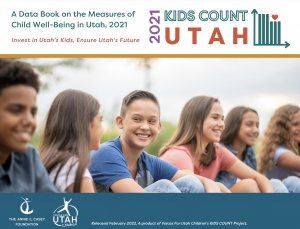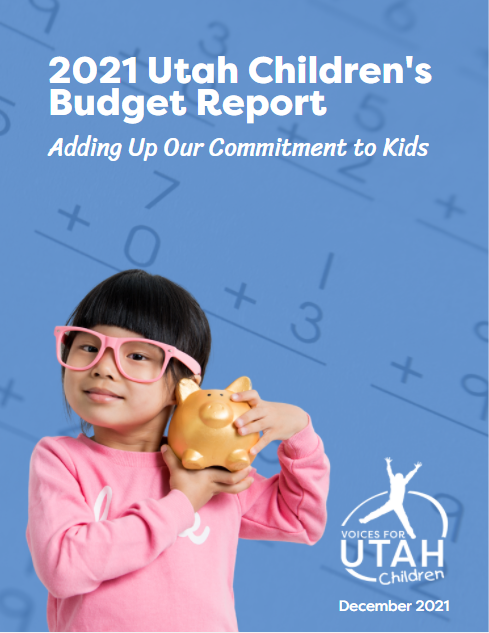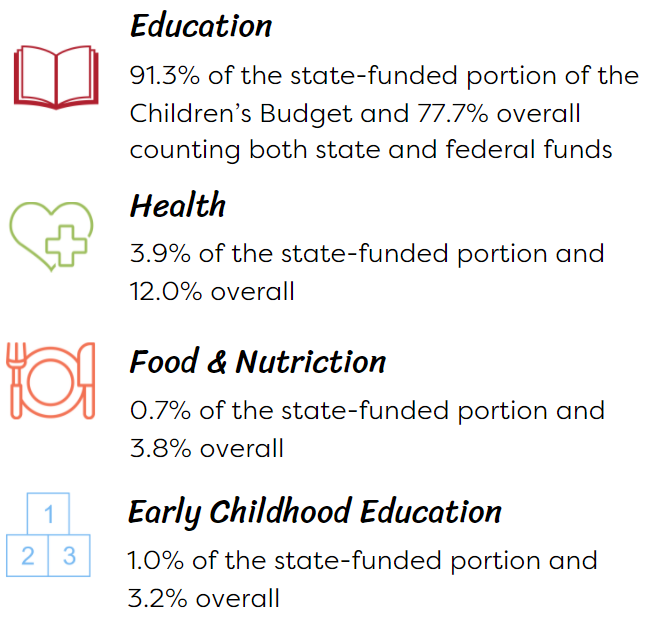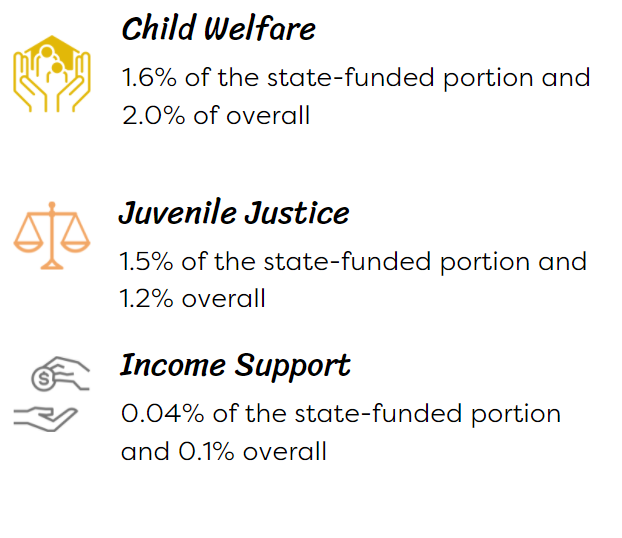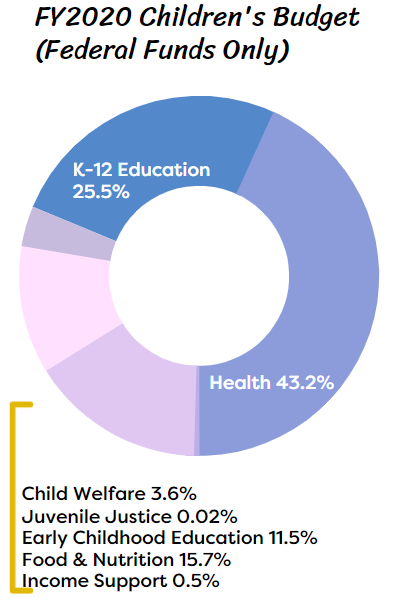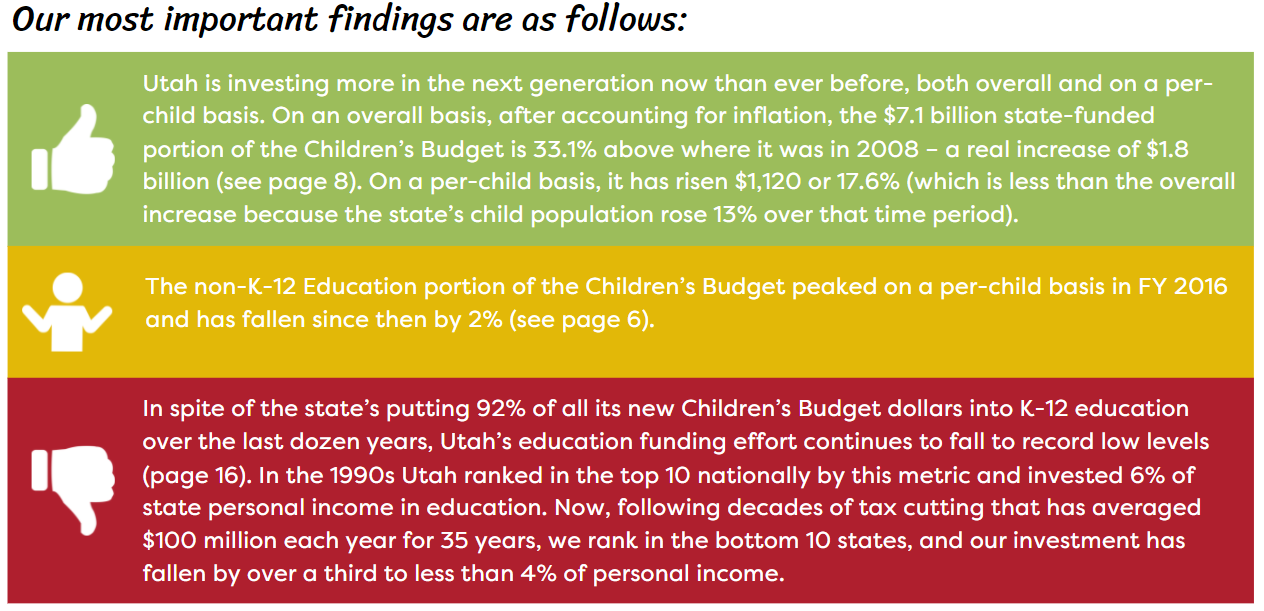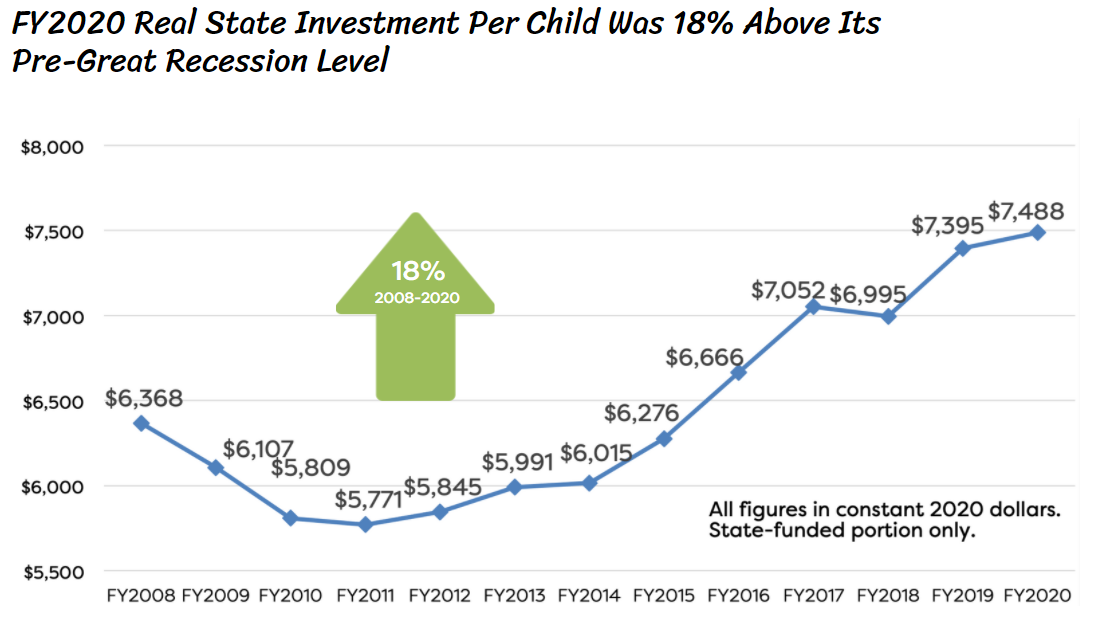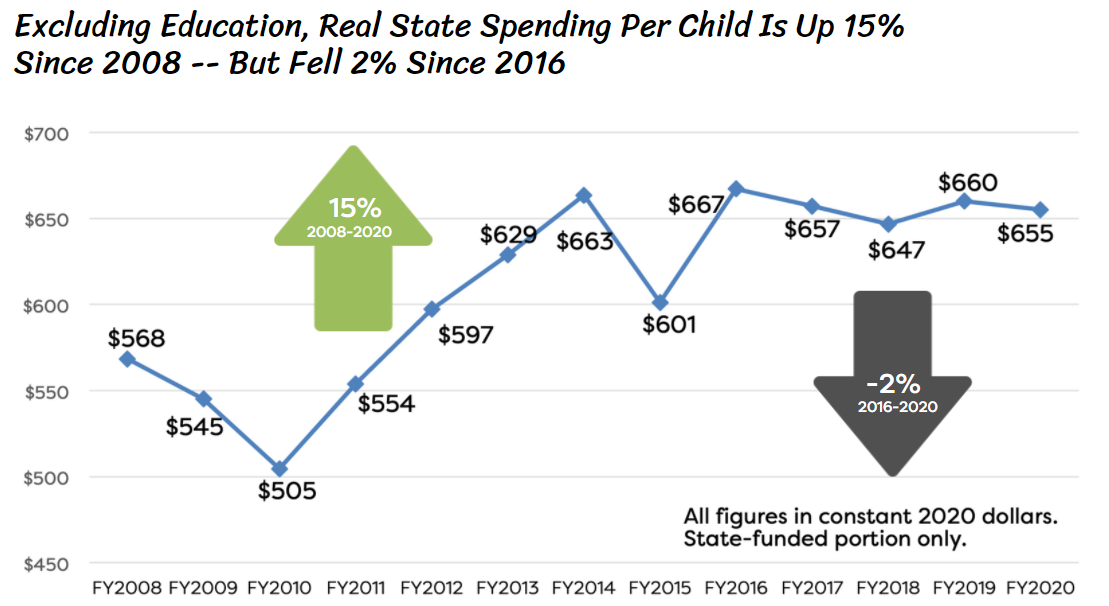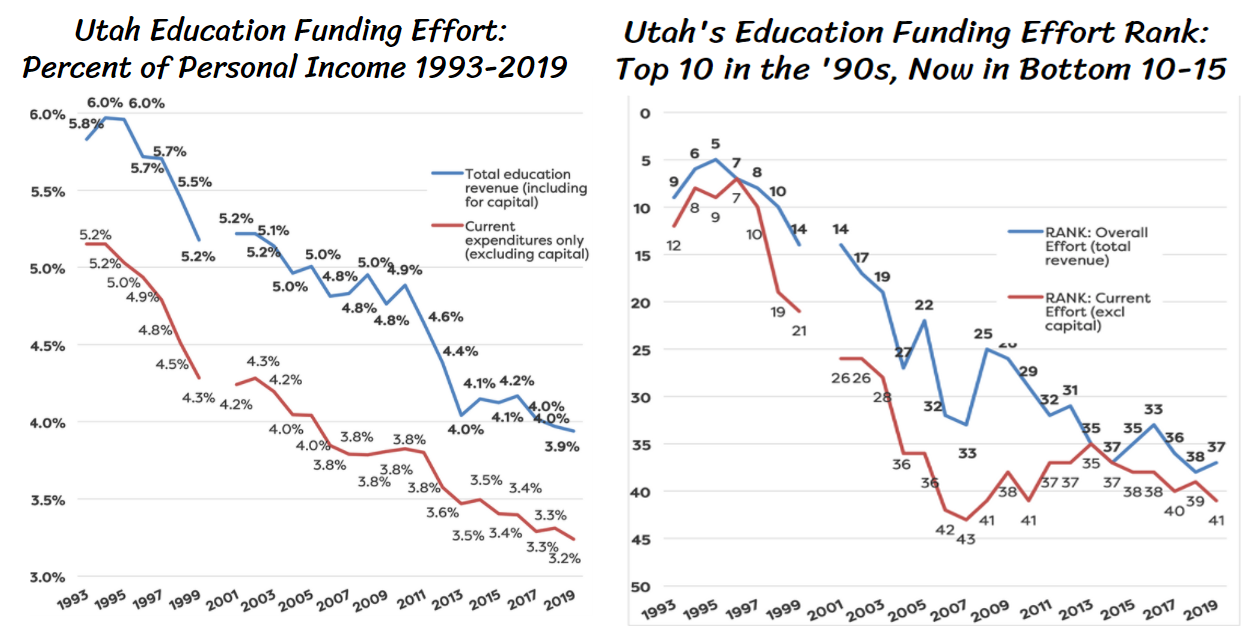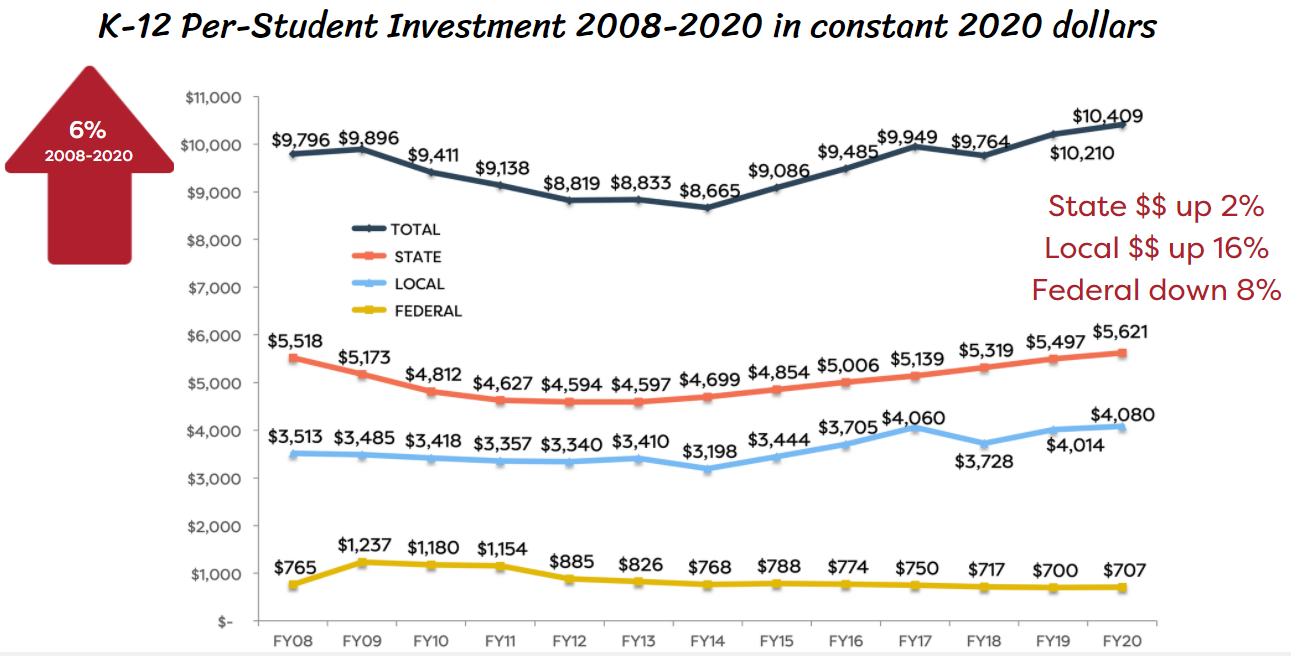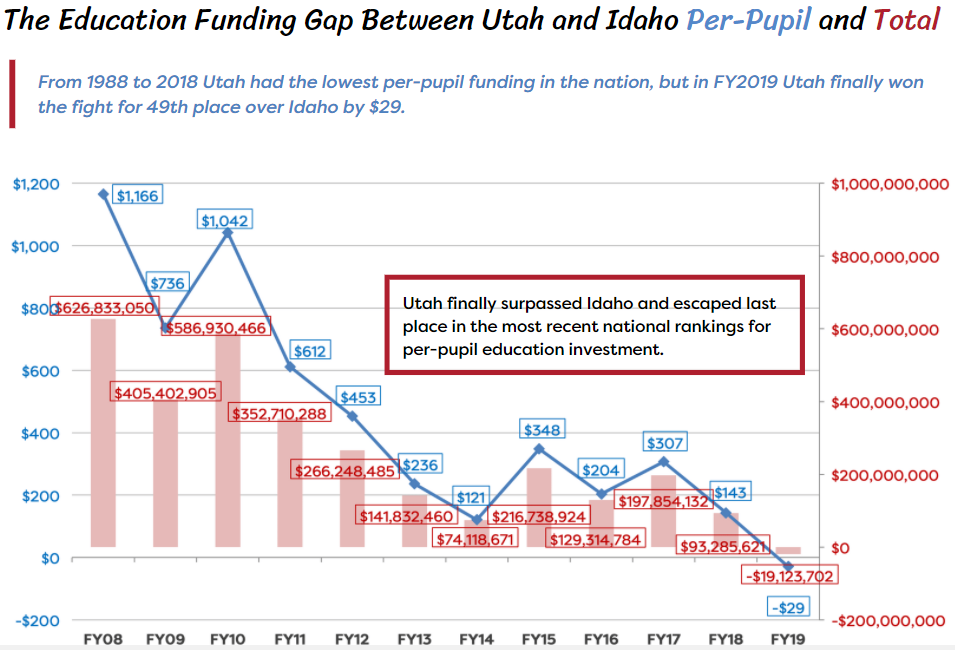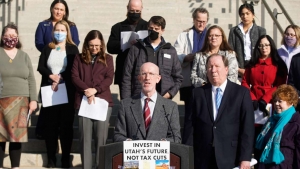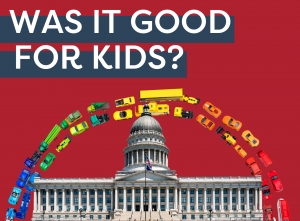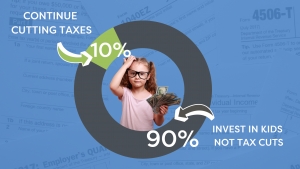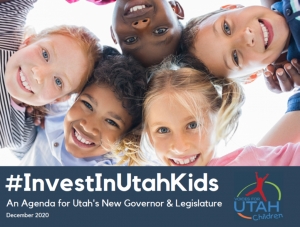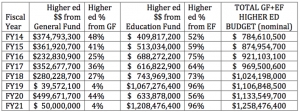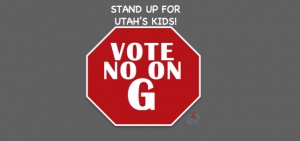Health
2021 Utah Kids Count Data Book Release
Kids Count Utah: A Data Book on the Measures of Child Well-Being in Utah, 2021 is the first glance at the effects of the COVID-19 pandemic on Utah’s children. Please click on the button below for the full report.
2021 UTAH KIDS COUNT DATA BOOK
Children under the age of 18 make up a third of the state’s population. Not surprisingly, Utah children and their families faced additional challenges as a result of living through a global pandemic.
Unfortunately, over 10 percent of Utah children are experiencing poverty. Additionally, since 2019 Utah saw an increase of over 4,000 additional children considered to be in Intergenerational Poverty (IGP). More children caught in a cycle of IGP is concerning as it could mean that their own children may continue that same cycle if their economic situation does not improve.
Providing a quality education to children during the pandemic continues to be a challenge. The most recent data shows that student proficiency assessment results decreased over the past year. And data also shows that many children are not receiving the mental health treatment they need. A new data indicator shared in the 2021 data book looked at access to mental health. The data collected from the National Survey of Children’s Health shows that approximately 60% of three- to 17-year-olds struggling with mental health are not receiving treatment.
Voices for Utah Children hopes that the yearly KIDS COUNT data book project and the publication of Measuring of Child Well-Being in Utah continues to be a valuable resource that can provide guidance to both policymakers and the general public on how to improve the lives and futures of Utah children.
Utah Children's Budget Report 2021
Children’s Budget Report Finds Utah Is Spending More On Children Than Ever Before, But Education Funding Effort Is At A Record Low
Salt Lake City, December 9, 2021 - Voices for Utah Children, the state’s leading children’s policy advocacy organization, released its biennial Children's Budget Report. The report, published every other year, measures how much (before and after inflation) the state invests every year in Utah’s children by dividing all state programs concerning children (which add up to about half of the overall state budget) into seven categories, without regard to their location within the structure of state government. The seven categories are as follows, in descending order by dollar value (adding state and federal funds together):
Public investment in children should be understood as a central component of Utah’s economic development strategy. Examining how much Utah invests in children can help the state evaluate whether it is maximizing the potential of our future workforce through our investment in human capital.
This is especially important given the rapid demographic changes taking place in our state. The 2020 Census found that 30% of Utahns under 18 are members of a racial or ethnic minority (almost one-third of our future workforce), compared to just 24% in 2010. The investments we make today in reducing racial and ethnic gaps among Utah’s children will enable the state to thrive and prosper for generations to come

Report highlights are as follows
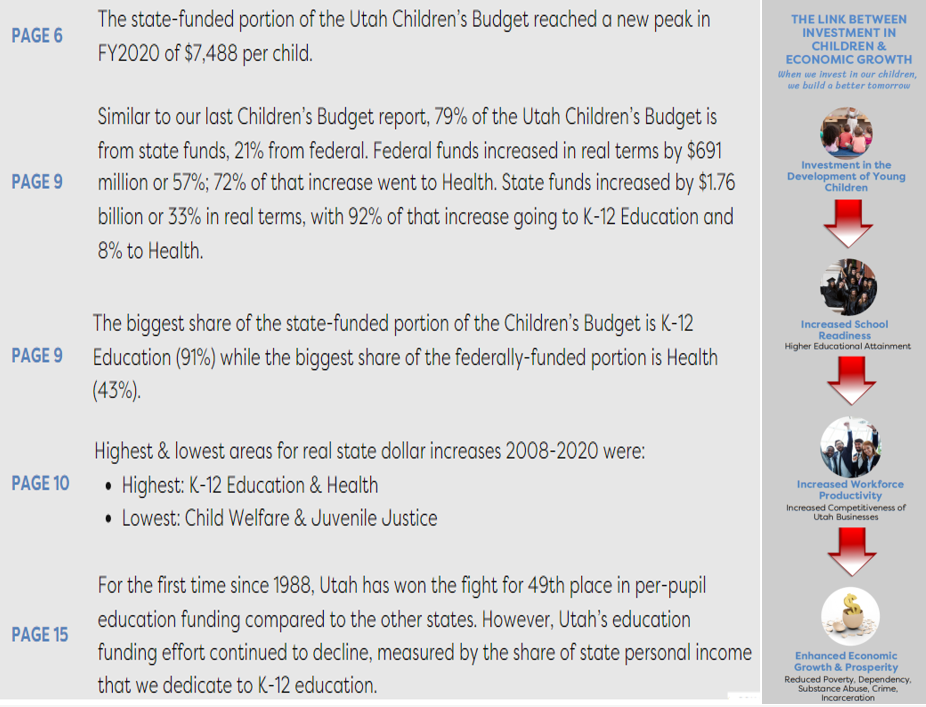
Good News: Utah is investing more in the next generation now than ever before, both overall and on a per-child basis
Not-so-good News: The non-K-12 Education portion of the Children’s Budget peaked on a per-child basis in FY 2016 and has fallen since then by 2%
Bad News: Utah’s education funding effort continues to fall to record low levels
Additional Trends: Changes in Funding by Source
Trends in Education Funding: UT beat ID for 49th place, still far behind US overall
MEDIA COVERAGE OF THE CHILDREN'S BUDGET REPORT:
Facebook Live Event presenting the 2021 Children's Budget Report, major findings and summaries of all the categories of funding that impact children in Utah. https://fb.watch/9O05ECPAHi/
Invest in Utah's Future, Not Tax Cuts
BROAD COALITION CALLS FOR INVESTMENT IN UTAH’S FUTURE, NOT TAX CUTS, DOCUMENTS $5.2 BILLION IN URGENT UNMET NEEDS
Salt Lake City – On Monday, November 8, 2021 on the steps of the Utah Capitol, a broad and diverse coalition of advocates for the poor, for disabled Utahns, for education, health care, clean air, and a variety of other popular Utah priorities held a press conference calling on the Utah Legislature to avoid cutting taxes until it has developed a comprehensive plan to address Utahns’ top concerns by investing in Utah’s future.
Following nearly two years of the COVID-19 pandemic, Utah is fortunate to have achieved a more rapid economic recovery than nearly every other state. Utah has also received billions in federal assistance that have padded state revenues – but only temporarily. It is expected that the Governor and Legislature will have at least $2.5 billion in new revenues to appropriate in the 2022 General Session of the Utah Legislature.
This has led some to say that Utah is “swimming in money” and should cut the state income tax rate from 4.95 to 4.5%, a tax break of $600 million (that mostly benefits upper income families rather than Utahns in need). This tax break would be over and above the roughly $3.5 billion that the Legislature has already cut from annual revenues in recent decades (seehttps://le.utah.gov/interim/2021/pdf/00003683.pdf slide #3).
In response, today the Invest in Utah’s Future coalition presented a list of urgent unmet needs amounting to $5.2 billion, more than double the amount of the expected new revenues.
The advocates also pointed out that, according to recent reports from the Utah State Tax Commission and the Utah Foundation, taxes in Utah are the lowest that they have been in decades, following repeated rounds of tax cutting. “We understand that tax cuts are popular, but we’ve reached the point where we must ask ourselves: Are we, as the current generation of Utahns, meeting our responsibility, as earlier generations did, to set aside sufficient resources every year to invest in our children, in our future, in the foundations of the next generation’s prosperity and quality of life?” said Matthew Weinstein of Voices for Utah Children.
Speakers also referenced the recent public opinion survey by the Deseret News and Hinckley Institute that found that only 27% of Utahns support tax cutting over investing in Utah’s future, consistent with other polls done in recent years by the same organizations as well as by Envision Utah and the Utah Foundation.
Here is the list of urgent unmet needs that Utah has not been able to address due to the state’s chronic revenue shortages, adding up to a total of $5.2 billion:
| Budget Area | Amount | Details | Contacts |
| K-12: Reduce class sizes from 29 to 15 |
$1.1 billion ($612m K-6 only) |
Reduce class sizes/improve student/teacher ratio below the current Utah average of 29 (vs national average of 24) to optimum class size of 15. (Source: UEA) |
Utah Education Association Director of Policy and Research Jay Blain |
| K-12: Paraeducators | $312 million |
Expand paraeducators to all Utah elementary classrooms. (Source: UEA) |
|
|
K-12: Increase school counselors |
$130 million |
Increase school counselors per student to the national standard optimum of 1:250. Utah’s current ratio is 1:648, compared to the national average of 1:455. (Source: UEA) |
|
| K-12: school psychologists, social workers and special ed teachers | $285 million |
Increase student access to school psychologists, social workers and special ed teachers. (Source: UEA) Current and optimal ratios are: School psychologists: Now 1:1950/Optimal 1:500 Social workers: Now 1:3000/Optimal 1:250 Special ed teachers: Now 1:35/Optimal 1:25 |
|
| K-12 Education: reduce teacher attrition and shortages | $500-600 million | Envision Utah estimates that we need to invest an additional $500-600 million each year just to reduce teacher turnover, where we rank among the worst in the nation. Our leaders’ unwillingness to solve our education underinvestment problem is why the majority-minority gaps in Utah’s high school graduation rates are worse than nationally and our younger generation of adults (age 25-34) have fallen behind their counterparts nationally for educational attainment at the college level (BA/BS+). | |
| K-12 School Nurses | $84.4 million |
The Utah Department of Health annual report “Nursing Services in Utah Public Schools 2020-21” found that it would cost $84.4m to hire an additional 844 nurses so as to have one nurse in every public school building. There are currently only 224 nurse FTEs in Utah’s public schools, a ratio of 1 nurse for every 2,617 students. One nurse in every building would improve that ratio to 1:623, which would still be worse than the national average. Sources: www.utahschoolnurses.org/, www.nasn.org, www.sltrib.com/opinion/commentary/2021/10/01/diane-nicoll-utah-schools/ |
Dr. Jennifer Brinton, MD, President, American Academy of Pediatrics – Utah and Dr. William Cosgrove, Past-President - |
|
K-12: Homeless Students |
$105.8 million |
HUD vouchers do not cover students and their families who are homeless under McKinney Vento Dept. of Education definition. For the 2019-2020 school year, Utah had a little over 13,500 K-12 homeless students. Some of them are duplicates as students move from one district to another. Also the same household has multiple children. If we assume we have:
Source: Utah Housing Coalition |
Utah Housing Coalition Advocacy & Outreach Coordinator Francisca Blanc – |
| Full Day Kindergarten |
$52.5 million |
Voices for Utah Children estimates that it will cost $52.5 million to make full-day Kindergarten available to all Utah families who would choose to opt in to it. | Voices for Utah Children Sr. Policy Analyst Anna Thomas and Pastor Brigette Weier, Our Saviour’s Lutheran Church |
| Pre-K and Child Care |
$1 billion |
Well over $1 billion is one estimate for a much needed comprehensive system of early childhood care and education (pre-k) in Utah. | |
| Afterschool Programs |
$3.6 million |
Utah’s 303 afterschool programs serve 43,000 kids but still leave 99,000 unsupervised every day after school. During this past year’s 21st Century Community Learning Center grant competition in Utah, $1,062,816 was available and there was $4.6 million in requests, indicating a $3.6 million funding gap. (Source: Utah Afterschool Network) | Utah Afterschool Network Director Ben Trentelman – |
| Health Insurance: Children | $5 million | It would cost Utah about $5 million to pay for SB158 to remove barriers to health insurance coverage so that all Utah kids can access health insurance, including 12-month continuous eligibility. Utah currently ranks last in the nation for covering the one-in-six Utah kids who are Latinx and in the bottom 5 states for all children. Source: Voices for Utah Children | Voices for Utah Children Deputy Director Jessie Mandle |
|
Health Insurance: New parents |
$5 million | Extending Post-Partum Medicaid Coverage for new parents up to one year (now just 60 days) Source: Voices for Utah Children | |
| Mental Health & Substance Use Disorder Treatment | Uncertain |
Utah ranks last in the nation for mental health treatment access, according to a 2019 report from the Gardner Policy Institute. A 2020 report from the Legislative Auditor General found that Utah’s Justice Reinvestment Initiative had failed to achieve its goal to reduce recidivism -- and actually saw recidivism rise -- in part because “both the availability and the quality of the drug addiction and mental health treatment are still inadequate.” (page 51) Stakeholders identify the highest priority items as: housing and workforce capacity. There is a need to expand student enrollment slots in universities for MSWs (Masters in Social Work), MFTs (Marriage & Family Therapists) and MHCs (Mental Health Counselors), and to provide scholarships at these institutions to attract students. |
|
| Disability Services | $30 million |
The DSPD disability services waiting list has doubled in the last decade from 1,953 people with disabilities in 2010 to 3,911 in 2020. The FY20 $1 million one-time appropriation made it possible to provide services to 143 people from the waiting list, implying that it could cost $30 million to eliminate the waiting list entirely. |
Legislative Coalition for People with Disabilities – Jan Ferre |
|
Rural Utah Economic Development |
Uncertain | Rural Utahns should not feel that they need to abandon their home communities and add to the growth pressures along the Wasatch Front in order to provide for their families. Rural economic development would benefit all Utahns and reduce disparities between the Wasatch Front and other areas of the state. | Community Action Partnership of Utah - Stefanie Jones and Clint Cottam – |
| Transportation Access | $300 million |
Increase access to employment and educational opportunities for more people, especially lower-income communities. Provide additional transit connections, including extended evening and weekend service. Establish more ‘active transportation‘ (bike and pedestrian) connections to increase equity of access. Source: Wasatch Front Regional Council |
|
| Left Behind Workers and Families | $154 million |
Last year’s report “Left Out: Adding Up the Cost of Excluding Undocumented Utahns from State and Federal COVID-19 Relief” showed how undocumented Utahns and their families (comprising 39,000 households with over 100,000 individuals) work hard and pay taxes but were excluded from $154 million of federal COVID and unemployment relief. |
Comunidades Unidas – Brianna Puga – |
| Sexual and Domestic Violence | $85 million |
Our economy incurs steep economic costs as a result of sexual and domestic violence. The Center for Disease Control estimates that over a lifetime the costs for a female survivor are $103,762 and for a male survivor $23,414. These include medical costs, loss of employment or interruption of paid work, criminal justice system costs, among others. The Utah Domestic Violence Coalition 2017 Needs Assessment identified insufficient funding for shelters, affordable housing, child care, legal representation, and mental health and substance abuse treatment services as major obstacles to protecting women from domestic violence. In the 2021 Utah Legislative Session, fourteen private non-profit domestic violence service providers submitted an appropriations request of $3.4 million in ongoing state funds. However, only $1.7 million was funded through federal TANF funds. No ongoing state funds were approved. Unfortunately, only two domestic violence service providers were able to accept and utilize the TANF funds. The remaining twelve domestic violence service providers were unable to accept those funds because TANF eligibility requirements conflict with Violence Against Women Act (VAWA) confidentiality provisions. The actual cost to meet the needs of Utahns experiencing sexual and domestic violence is much higher than is reflected in the 2021 appropriations request and has been estimated to total $85 million. (Source: Utah Domestic Violence Coalition, Utah Coalition Against Sexual Assault, Restoring Ancestral Winds) |
Gabriella Archuleta, Director of Public Policy, YWCA Utah and Yolanda Francisco-Nez, Executive Director of Restoring Ancestral Winds |
| Housing | $415 million |
Funding to build affordable housing state-wide for people earning less than 50% AMI. In Salt Lake County alone, the current need is $1 billion. Affordable housing units fall 41,266 units short of meeting the need for the 64,797 households earning less than $24,600. Among extremely low-income renter households, 71% pay more than 50% of their income for housing, which is considered a severe housing burden. For more information on the current and ongoing needs visit https://endutahhomelessness.org/wp-content/uploads/2021/06/HousingNow-Deck-12.pdf |
|
| Homeless Services | $55 million | Case manager positions have been underfunded for the past several years and most do not make a living wage. The homeless resource centers in Salt Lake County also maintain a perpetual gap in state funding of at least $3 million per year. In 2019, homeless service providers across the state sought $41 million in funding for ongoing programs, including case management. At that time, the state provided $12 million. The following year, the state provided $9 million. Covering even the basic needs of providers would be a huge step forward in our efforts to reduce homelessness across the state. | |
| Housing for Seniors |
$30 million/ year for 10 years |
If we don’t fund preservation of affordable housing for seniors we will lose valuable units. A very general estimate would be $50,000 per unit for perhaps 5,000 units. This equates to $250 million in rehab costs. What is more realistic is subsidizing 5,000 at say $500 per month or $30 million per year which would allow these projects to Borrow the money for rehab. Over 10 years the total is $300 million but the state would pay this over 10 years. The $250 million up front to rehab the units would likely keep them going for 10 years, then more rehab would be required. https://www.utahhousing.org/preserving-senior-affordable-housing-report.html https://nyuds.maps.arcgis.com/apps/webappviewer/index.html?id=b8318f874017488ea9bdd51a296e59ef for senior housing report |
Utah Housing Coalition Director Tara Rollins |
| Air Quality | $100 million | In 2018 Gov. Gary Herbert proposed $100 million for clean air initiatives but the Legislature did not fully fund this goal.
The Wasatch Front ranks as the 11th worst air quality in the nation for ozone and 7th worst for short-term particle pollution. Investments should align with the principles in Kem C. Gardner Policy Institute Road Map, and have fallen short in previous years. |
|
| Air Quality in Schools |
$35 million |
Funding for air purifiers in every classroom in Utah, which would reduce the risks both from COVID and from Utah’s air pollution and could be expected to result in improved school performance, even more than standard interventions such as reducing class size by 30%, or “high dose” tutoring. (Source: Utah Physicians for a Healthy Environment) | UPHE Director Jonny Vasic - |
| Air Quality: Promote Transit | $60 million | Funding for UTA to eliminate fares entirely on all UTA conveyances as has been done already in dozens of cities to varying degrees, including in the SLC Free Fare Zone. (Source: Steve Erickson fiscal estimate, https://freepublictransport.info/city/ ) | Steve Erickson - |
| Hunger | Uncertain | It is clear that the state needs to do more in providing funding and other resources to help support local community food pantries. Earlier this year, Utahns Against Hunger conducted a community food pantry survey and found that in 2020, a quarter of pantry respondents had a funding gap, with 15% of respondents having a gap of $10,000 or more. | Utahns Against Hunger – Gina Cornia – and Alex Cragun |
| Utah EITC |
$100 million |
Utah should become the 31st state to offer a 20% state match to this highly popular federal tax break. This refundable tax cut targeted to low- and moderate-income working families has been proven to reduce poverty by drawing lower-skilled persons into the workforce, moving them toward independence and self-sufficiency. Most of this tax cut goes to the lowest income fifth of Utahns, those earning under $28,000, and the rest goes to the second fifth of the income scale, those earning under $50,000. | Voices for Utah Children – Matthew Weinstein – |
| Eliminate the sales tax on unprepared food | $130 million |
The food tax is the most regressive tax. One-third of it is paid by the lowest-income half of Utah households, who earn less than a sixth of all Utah income. According to the U.S. Department of Agriculture’s Economic Research Service, low-income families pay 36% of their income on food while higher-income families spend only 8%. This is why 37 states do not charge any sales tax on food. |
Rev Libby Hunter, Cathedral Church of St. Mark, speaking on behalf of the Coalition of Religious Communities (Bill Tibbitts – ) |
| About those water project boondoggles… | Federal rules permit the use of ARPA funds for water infrastructure projects, but Utah would save billions of dollars and millions of gallons by investing in conservation first to reduce usage in one of the most water-wasteful states in the nation. Those ARPA dollars would be better used addressing the urgent unmet human needs of our fellow Utahns. | Utah Rivers Council – Zach Frankel – and Lindsey Hutchison | |
| Racial Equity, Diversity, and Inclusion |
Our public fiscal policies – how we generate and expend public investment dollars – have a direct impact on whether we are widening or narrowing the gaps between different groups in Utah. The new Utah Compact on Racial Equity, Diversity, and Inclusion must be more than just words on a page. https://slchamber.com/public-policy/utah-compact/ |
Angel Castillo, Ogden NAACP | |
TOTAL |
$5.177 billion – more than double the amount of “surplus” revenue that the Legislature expects to have |
||
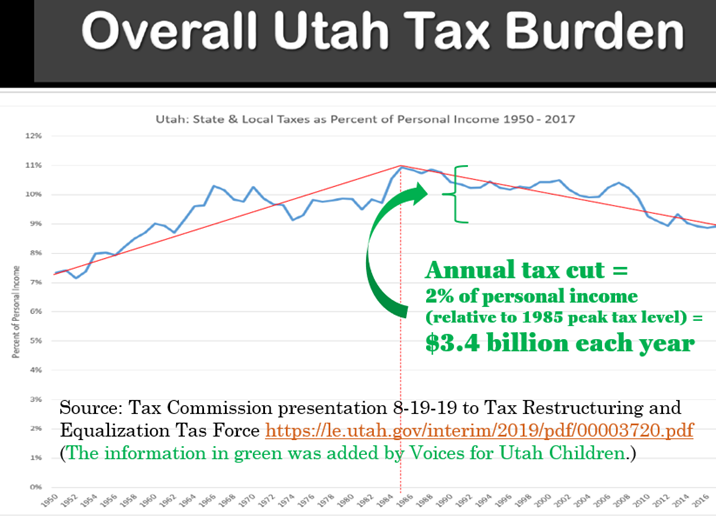

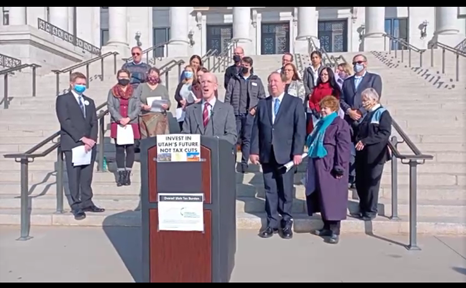
Live recording of the Invest in Utah's Future press conference 11/8/21: https://fb.watch/99bpgYEAqp/
Printable version of this document is here.
Media coverage is posted at KSL and Deseret News and Fox-13.
ONE PAGERS ABOUT THE VARIOUS UNMET NEEDS:
- K-12 education: UEA data infographic and UEA 2022 budget priorities
- K-12 school nurses info from American Academy of Pediatrics - Utah Chapter
- Rural Utah economic development from CAP-Utah and additional information from Governor's Office of Economic Opportunity
- Disability services information from annual report of the Utah Division for Services to People with Disabilities
- Air quality: Classroom air purifiers from Utah Physicians for a Healthy Environment
- Air quality and low-income transportation access: Free Fare UTA one-pager from Crossroads Urban Center
- Sexual and domestic violence one-pager from YWCA-Utah
- Sales tax on food op-ed from Deseret News
- Income tax rate cut vs Utah EITC one-page summary
NEW REPORT: Covering Uninsured Kids Will Save Utah Millions Every Year
Utah has 82,000 uninsured children, according to the most recent Census data, which means an estimated 8.3% of children in Utah do not have health insurance. Utah currently ranks 46th in the nation for insured children.
When it comes to addressing this problem, too often public debate focuses on the cost to taxpayers of insuring Utah’s 82,000 uninsured children. But what about the cost of not insuring children? Are there ways in which Utah taxpayers are already paying a price for allowing such a high number of uninsured children in our state?
In our new report, we address this question, building on findings from previous research. We explore two key ways in which Utah taxpayers are paying millions of dollars in costs annually for uninsured children:
1) Uncompensated care for Utah’s 82,000 uninsured children may be costing state and local governments in Utah about $8.8 million annually.
2) Covering all of Utah’s uninsured children would likely result in higher educational attainment levels, potentially adding nearly $10 million to Utah's personal income annually and generating over $800,000 in new tax revenue each year.

2021 Kids Count Data Book is Now Available!
We are pleased to announce that the Annie E. Casey Foundation has released the 2021 Kids Count Data Book.
Access the book today at www.aecf.org/databook
Background
For 15 years it has been the priority of the Utah KIDS COUNT Project to ensure that policymakers, advocates, community service providers, the media, and concerned citizens have quality data on how children are doing in our state. These yearly publications provide county level data on a variety of child well-being indicators.Utah showed strong gains in key indicators of child well-being from 2010 to 2019, according to the 2021 KIDS COUNT® Data Book, a 50-state report on child well-being by the Annie E. Casey Foundation analyzing how children are doing in four domains encompassing 16 child well-being indicators.
Summary of the 2021 Utah Kids Count Data
This year’s Data Book shows nearly a decade of progress in all but two of the indicators.
Troublesome indicators appear in the Health domain as low birth-weight babies and child and teen death rates both saw increases over the decade. The percentage of babies born at low birth weight rose from 7.0% in 2010 to 7.4% in 2019, a 6% increase; Utah fell in the national rankings from 12th to13th in this indicator. Similarly, the child and teen death rate rose from 24 deaths per 100,000 children in 2010 to 26 in 2019, an 8% increase. Utah fell in the rankings for this indicator from 14th to 24th.
While Utah showed improvement in most areas of child well-being over the last decade, when comparing 2020 data to 2021 data our rankings from last year fell in all but one category:
- Overall ranking fell from 4th to 5th
- Economic Well-Being fell from 2nd to 5th
- Health ranking fell from 13th to 18th
- Family and Community fell from 1st to 2nd
- Education remained the same at 10th
“The bad news is Utah is not keeping pace with the states that continue to improve,” said Terry Haven, deputy director of Voices for Utah Children, Utah’s member of the KIDS COUNT network.
“The good news is it wouldn’t take much to help our rankings start trending upward again. For example, if Utah wanted to rank number one in percentage of low birth-weight babies, it would only have to reduce the number by 532 babies.”
Impact of the Pandemic on Utah Kids
Sixteen indicators measuring four domains — economic well-being, education, health, and family and community context — are used by the Annie E. Casey Foundation in each year’s Data Book to assess child well-being. The annual KIDS COUNT data and rankings represent the most recent information available but do not capture the impact of the past year:
ECONOMIC WELL-BEING: In 2019, 91,000 children lived in households with an income below the poverty line. Nationally, Utah is praised for its economic success, but Utah families continue to face rapidly increasing housing costs. Utah ranked 10th in 2018 for children living in households that spend more than 30% of their income on housing, and the state dropped to 17th in 2019. With the current housing prices in Utah, it is quite possible this trend will get worse.
EDUCATION: In 2019, Utah education ranking held steady at 10th in the nation. However, Utah’s early education numbers still lag behind much of the country with close to 60% of 3- and 4-year olds not attending school. Utah ranks in the bottom third of states for this indicator.
AFFORDABLE HEALTH CARE: In 2019, 82,000 children in Utah did not have health insurance. The state made an effort to provide all children in Utah with health insurance through the passage of legislation. While the bill was enacted, not enough funding was appropriated to cover all kids. Utah continues to rank 41st in the nation for uninsured children.
FAMILY AND COMMUNITY CONTEXT: Utah has consistently ranked first in the category but fell a bit in 2019 to second. Utah did make improvements in the number of children in single-parent families. In 2018, Utah had 174,000 children in single-parent families but in 2019, the number dropped to 168,000 children.
Let's Continue to #InvestInUtahKids
Investing in children, families and communities is a priority to ensure an equitable and expansive recovery. Several of the Annie E. Casey Foundation’s suggestions have already been enacted in the American Rescue Plan, and additional recommendations include:
- Congress should make the expansion of the child tax credit permanent. The child tax credit has long had bipartisan support, so lawmakers should find common cause and ensure the largest one-year drop ever in child poverty is not followed by a surge.
- State and local governments should prioritize the recovery of hard-hit communities of color.
- States should expand income support that helps families care for their children. Permanently extending unemployment insurance eligibility to contract, gig and other workers and expanding state tax credits would benefit parents and children.
- States that have not done so should expand Medicaid under the Affordable Care Act. The American Rescue Plan offers incentives to do so.
- States should strengthen public schools and pathways to postsecondary education and training.
Release Information
The 2021 KIDS COUNT® Data Book is available at https://www.aecf.org/resources/2021-kids-count-data-book. Journalists interested in creating maps, graphs and rankings in stories about the Data Book can use the KIDS COUNT Data Center at datacenter.kidscount.org.
The 2021 Utah Legislative Session: Was It Good For Kids?
We appreciate the many legislators that supported bills affecting children. In summary, it WAS a good year for kids, but we still have plenty to do and we look forward to working together to #investinutahkids!
Early Childhood
Early childhood care and education had several key wins. The legislature approved:
-
$7m in new funding for Optional Enhanced Kindergarten (which many districts use, with other funding sources, to offer full-day kindergarten)
-
$3m in new funding for School Readiness grants (to support high-quality preschool programs)
-
$5m in newly restored funding for preK-3 teacher professional development.
-
In addition, new legislation directed expansion in eligibility for working families to receive state childcare support, and several bills aimed to create efficiencies and financial stability for the childcare providers these working families rely on.
Juvenile Justice
In the area of Juvenile Justice, legislators approved several bills that continue the state’s effort to refine ongoing efforts to reform and improve the juvenile justice system, which included:
-
A bold bill outlining and clarifying the Miranda rights of youth who are interrogated by police (ensuring that either parents or attorneys are present for such questioning.
-
An innovative pilot program to offer youth in secure care access to college courses through Dixie State University.
-
Finally, school-based discipline and the role of School Resource Officers (SROs) received some attention, with legislators giving a moratorium on criminal enforcement of state truancy laws during the remaining months of the pandemic and providing additional direction with regard to SRO training in public schools.
Health
We were thrilled to see our Legislature take significant steps to prioritize children’s health coverage this Session and reduce Utah’s too-high number of uninsured children.
-
House Bill 262 (Representative Welton) provides ongoing funding for CHIP/Medicaid outreach so that more families can connect with affordable health insurance options for their kids. In addition, Senate Bill 158 would have removed barriers to health insurance, so all Utah children could get covered and keep their coverage.
-
In addition to children’s coverage, we saw important steps forward for children’s access to mental health this legislative Session including HB 337, sponsored by Representative Eliason, which will allow more early childhood providers to receive valuable training in infant mental health and also strengthen statewide systems to respond to the mental health needs of young children.
-
The legislature also made changes to ensure that funding for Utah’s maternal mental health program and awareness campaign were made permanent; thanks to Representative Dailey-Provost for championing this change for families.
-
Finally, the legislature also passed a bill that will make it easier for kids to access preventive dental health care. Senate Bill 103, sponsored by Senator Todd Weiler, allows dental hygienists to bill Medicaid, which will help promote greater access to dental care in school-based and childcare settings.
Cover All Kids Campaign Update
Senate Bill 158 passed the Senate with broad support, but unfortunately it was not funded. We look forward to continuing to support the bill sponsor, Senator Luz Escamilla, and floor sponsor, Representative Francis Gibson, to get this important bill across the finish line next year.
Continuous Medicaid Eligibility Update
Unfortunately, the Legislature did not restore state funding for continuous eligibility for children on Medicaid ages 0-5. Continuous eligibility was funded in the 2020 General Session but eliminated as part of budgetary cuts over the summer. Continuous eligibility guarantees children will have a year of stable Medicaid coverage, as they already have with CHIP. The good news is that thanks to temporary federal requirements, all children currently have this option. However, when the federal public health emergency ends, this option will end too, which could lead to significant loss and disruptions in children’s coverage if state funding is not restored. This past year has shown us just how vital it is that all children and families across Utah have access to health care and coverage. Stable, affordable health coverage for all Utahns will be critical to our state’s ability to rebound and recover.
Other Legislative Priorities
During this past legislative session, we were happy to support a number of bills that are “good for kids” outside of our main policy priorities including the following bills that include policies that we will continue to work on this upcoming year!
- We supported and are glad to continue working with the International Rescue Committee on supporting our immigrant and refugee families through HCR 22: Concurrent Resolution Celebrating the Contributions of Multilingual and Multicultural Families to Utah Schools.
-
HB 338: School District Voter Eligibility Amendments would have created a pathway for school districts to choose whether students age 16-17 can vote in their local elections. It was led by a young person, Dhati Oomen, but unfortunately did not pass. We will continue to further advocate for greater youth civic engagement through this bill and beyond.
-
Lastly, we supported and advocated for SB 214: Official Language Amendments as a positive first step to ensure we have greater language inclusion in our state. While we recognize that this is not a full repeal of the 2000 “English-only” law, this bill does remove funding restrictions and “official communications that exist” while keeping English as the official language in place. We will continue to work on ensuring this law is repealed completely in the coming year.
Tax and Budget
Tax cuts were a big item of discussion, and there were three tax cuts passed:
-
There was an $18 million Social Security Income Tax Credit
-
$24 million Military Retirement Income Tax Credit
-
$55 million Tax Cut tied to the personal exemption related to the dependent tax credit.
Voices opposed these three items as they were primarily a benefit to the top 40% of taxpayers and excluded the lowest-income 40% almost entirely.
We were also advocating for a $7 million Earned Income Tax Credit equal to 10% of the federal EITC targeted to Utahns in intergenerational poverty. This was passed in December 2019 as part of the tax restructuring law that was repealed in the 2020 Session. Lastly, there were two bills to lower the State Income Tax Rate, which did not pass. We were opposed to both bills for a number of reasons. The cuts would have led to a more regressive tax structure and depriving us of much needed future revenues.
We have many unfunded needs and it is our opinion that we should not cut taxes any further until we address those needs and provide the required funds.
>> Check out our Facebook page for FB Live updates of each policy area.
The High Price of Lower Taxes
Legislative leaders have said that 2021 should be “the year of the tax cut.” Numerous public opinion surveys show that Utahns disagree. This may come as a surprise to policymakers, who have been in the habit of handing out tax break after tax break for decades.
But there seems to be an increasing public awareness that Utah is now paying a price for decades of tax cutting that have left us with the lowest overall tax level in 50 years relative to Utah personal income.
UTAH'S URGENT UNMET NEEDS
We all like being able to pay less in taxes. But there is a growing understanding that tax cuts are leaving us unable to address the long list of urgent unmet needs in education, infrastructure, social services, air quality, public health, and many other areas that affect our standard of living and quality of life. All of these issues will shape the Utah that our children will one day inherit.
Outlined below are some examples of the urgent unmet needs in Utah.
Early Care and Education
Amount |
Unmet Need |
| $500-600 Million/Year |
Envision Utah estimates that we need to invest an additional $500-600 million each year just to reduce teacher turnover, where we rank among the worst in the nation. Our leaders’ unwillingness to solve our education underinvestment problem is why our high school graduation rate is below the national average (after adjusting for demographics) and our younger generation of adults (age 25-34) have fallen behind their counterparts nationally for educational attainment at the college level (BA/BS+). |
| $52.5 Million/Year | Voices for Utah Children estimates that it will cost $52.5 million to make full-day Kindergarten available to all Utah families who would choose to opt in to it. |
| $1 Billion | Well over $1 billion is one estimate for a much needed comprehensive system of early childhood care and education (pre-k) in Utah. |
Health
Amount |
Unmet Need |
| $59 Million/Year |
It would cost Utah about $59 million each year to cover all of our 82,000 uninsured children. The longstanding preference for tax cuts over covering all kids is why we rank last in the nation for covering the one-in-six Utah kids who are Latinx and why the state as a whole ranks in the bottom 10 nationally for uninsured children. |
Human Services
Area |
Unmet Need |
| Mental Health & Substance Abuse Treatment |
Utah ranks last in the nation for mental health treatment access, according to a 2019 report from the Gardner Policy Institute. A 2020 report from the Legislative Auditor General found that Utah’s Justice Reinvestment Initiative had failed to achieve its goal to reduce recidivism -- and actually saw recidivism rise -- in part because “both the availability and the quality of the drug addiction and mental health treatment are still inadequate.” (pg 51) |
| Disability Services |
The DSPD disability services waiting list has doubled in the last decade from 1,953 people with disabilities in 2010 to 3,911 in 2020. The FY20 $1 million one-time appropriation made it possible to provide services to 143 people from the waiting list. |
| Domestic Violence | The Utah Domestic Violence Coalition 2017 Needs Assessment identified insufficient funding for shelters, affordable housing, child care, legal representation, and mental health and substance abuse treatment services as major obstacles to protecting women from domestic violence. |
| Seniors |
The official poverty measure undercounts senior poverty by about a third because it does not consider the impact of out-of-pocket medical expenses. A 2018 study found that seniors spent $5,503 per person on out-of-pocket medical expenses in 2013, making up 41% of their Social Security income. (For most seniors, Social Security is the majority of their income, and it makes up 90% or more of income for 21% of married couples and about 45% of unmarried seniors.) |
Infrastructure, Environment, and Housing
Area |
Unmet Need |
| Infrastructure |
The American Society of Civil Engineers gives Utah a C+ grade for infrastructure in its December 2020 report. The Utah Transportation Coalition has identified a funding shortfall of nearly $8 billion over the next two decades. |
| Air Quality | The Wasatch Front ranks as the 11th worst air quality in the nation for ozone and 7th worst for short-term particle pollution |
| Housing |
Affordable housing units fall 41,266 units short of meeting the need for the 64,797 households earning less than $24,600. Among extremely low-income renter households, 71% pay more than 50% of their income for housing, which is considered a severe housing burden. The FY21 affordable housing appropriation request for $35 million from Sen. Anderegg, which was already just a small step in the right direction, was reduced to just $5 million. |
WHY TAX CUTS ARE A BIG DEAL
Some legislators have said to us, "What's the big deal with $100 million of tax cuts out of a $22 billion budget?".
The big deal is that we’ve been cutting, on average, about $100 million every single year for the last 25 years.
Voices for Utah Children’s research has found that tax cuts from the last 25 years has left us short $2.4 billion each year, amounting to an 18% cut to public revenues.
One could even call us a “slow-motion Kansas” because in 2012 they cut taxes overnight by 15%, leading to an economic slump and political backlash that saw the Republican legislature reverse the cuts in 2017 and the public elect a Democratic governor in 2018.
But here in Utah, we’re like the proverbial frog in the pot of water heating on the stove. The devastating impacts of these revenue reductions have been slow and incremental, so we’ve come to accept as normal a state of affairs that Kansans quickly reversed.
Instead of figuring out the fairest way to restore some of those lost revenues so we can address our most urgent challenges, Utah’s political leadership continues to pass new tax cuts every year, generally skewed toward the top of the income scale.
For example, Voices for Utah Children analyzed two of the tax cuts proposed this year and found that they excluded lower-income Utahns completely and mostly went to the highest-income households – even though their supporters said publicly that they are intended to help low- and middle-income Utahns.
Public opinion surveys conducted last year by the Deseret News and Hinckley Institute, by the Utah Foundation, and by Envision Utah all found a strong popular preference for public investment over tax cuts.
Same thing with surveys this month by the Deseret News-Hinckley Institute and by Voices for Utah Children.
Breaking old habits can be hard. As is often the case, the public appears to be ahead of our political leaders. But let's hope that they too will eventually come to appreciate the wisdom of their constituents, who are increasingly aware of the high price Utah is paying for lower taxes.
Utah has been fortunate in weathering the current recession. This gives us a unique opportunity to be able to make smart long-term investments at a time when other states are cutting budgets. As a State we need to take advantage of this situation and invest in Utah kids, not tax cuts.
THIS OP-ED APPEARED IN THE SALT LAKE TRIBUNE ON MARCH 1, 2021
#InvestInUtahKids: An Agenda for Utah's New Governor and Legislature
Salt Lake City - Voices for Utah Children released publicly today (January 6, 2021) "#InvestInUtahKids: An Agenda for Utah's New Governor and Legislature," the first major publication of our new #InvestInUtahKids initiative.
Utah begins a new era in this first week of January, with the swearing in of a new Governor and Lt. Governor and a new Legislature. The arrival of 2021 marks the first time in over a decade that the state has seen this kind of leadership transition. Last month Voices for Utah Children began sharing with the Governor-elect and his transition teams the new publication, and on Wednesday morning Voices will share it with the public as well.
The new publication raises concerns about the growing gaps among Utah's different racial, ethnic, and economic groups and lays out the most urgent and effective policies to close those gaps and help all Utah children achieve their full potential in the years to come in five policy areas:
- Early education
- K-12 education
- Healthcare
- Juvenile justice
- Immigrant family justice
The report, which was initially created in December and distributed to the incoming Governor and his transition teams, closes with a discussion of how to pay for the proposed #InvestInUtahKids policy agenda. The pdf of the report can be downloaded here.
Amendment G Passed. Now What Happens?
With Amendment G winning 54% of the vote this month, many of our partners and supporters have been asking us: What’s going to happen next?
What changes will result from this Constitutional amendment going into effect January 1, 2021, along with the legislation triggered by it (HB 357)?
The short answer is, “Probably not a lot, at least not immediately, but possibly quite a bit over the long term.”
As a result of the passage of Amendment G, the Utah Constitution Article XIII, Section 5, paragraph 5 changes from
“All revenue from taxes on intangible property or from a tax on income shall be used to support the systems of public education and higher education as defined in Article X, Section 2.”
to the following:
“All revenue from taxes on intangible property or from a tax on income shall be used:
(a) to support the systems of public education and higher education as defined in Article X, Section 2; and
(b) to support children and to support individuals with a disability.”
The state’s budget leaders sought this change because they expect the long-term trend to continue of Utah’s higher education budget shifting from the General Fund (which is financed mainly by the sales tax) to the Education Fund (which is financed mainly by the income tax). This shift has made it possible to make more of the General Fund available for social and healthcare services. But once higher ed has shifted completely out of the General Fund, something expected to happen in the coming years, then budget writers will no longer have a mechanism to free up additional funds to meet the state’s obligations for healthcare and social services. This concern is what drove the decision to place on the ballot a Constitutional amendment to allow budget writers to begin to shift additional items (services for children and for Utahns with disabilities) out of the General Fund and have them financed by the income tax.
In the FY21 budget passed by the Legislature in March and then adjusted in June (the FY21 budget year runs from July 1, 2020 through June 30, 2021), just 4% of the higher education budget came from the General Fund and the remaining 96% from the Education Fund. The chart below shows how the higher education budget has been divided between the two funds in recent fiscal years:
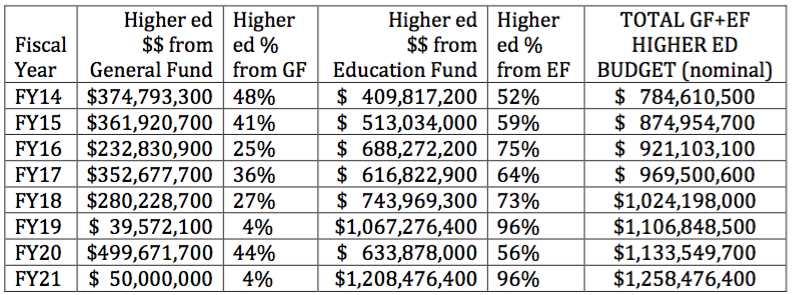
Source: Office of Legislative Fiscal Analyst annual publication “Budget of the State of Utah” at https://le.utah.gov/asp/lfa/lfareports.asp?src=LFAAR
While the trend has not been a straight line, the general direction has been to shift the higher education budget out of the General Fund and into the Education Fund. And, indeed, two of the last three budgets have seen 96% of the higher education budget come out of the Education Fund.
This trend has also been facilitated by the fact that income tax revenue has been growing faster than sales tax revenue.
Assuming these trends continue, we can expect to see the FY22 and future year budgets begin to make gradually increasing use of income tax revenue to finance social and healthcare services for children and Utahns with disabilities, two items that until now were only funded from sales tax revenue (through the General Fund).
What will be the impact of Amendment G on education funding?
As part of the political deal that produced Amendment G, the Legislature passed HB 357, with implementation contingent on voter approval of Amendment G. HB 357 contains three main provisions intended to provide education advocates with compensation for losing the Constitutional earmark of the income tax for education:
- It requires that “when preparing the Public Education Base Budget, the Office of the Legislative Fiscal Analyst shall include appropriations to the Minimum School Program from the Uniform School Fund… in an amount that is greater than or equal to:
(a) the ongoing appropriations to the Minimum School Program in the current fiscal year; and
(b) … enrollment growth and inflation estimates…”
This is intended to avoid what happened in the Great Recession a decade ago, when annual appropriations were not sufficient to keep up with inflation and enrollment growth, and it took almost a decade to restore real per-student education appropriations.
- It requires that 15% of education revenue growth go into a new “Public Education Economic Stabilization Restricted Account” to be saved for recessions until it reaches 11% of the full Uniform School Fund. This is intended to build up a new reserve fund of about $400 million to finance the first commitment mentioned above, the commitment that education funding will always increase by enough to cover enrollment growth and inflation, even in times of recession. This new annual 15% savings requirement will mean smaller education funding increases in good times and larger ones in bad times, in effect smoothing out the annual changes in education funding. It does not change the overall amount available for education budgets over the full course of each economic cycle.
- HB 357 allows local districts to reallocate capital funds to cover operating expenses in recession years. This is something that was allowed on a one-time basis in the Great Recession a decade ago. Now it will be allowed in any year when the Legislature makes use of the new Public Education Economic Stabilization Restricted Account.
What impact will Amendment G and HB 357 have on funding for social and healthcare services for children?
On the positive side, budget writers will now have increased flexibility to use income tax revenues that are now going to education for social and healthcare services for children and Utahns with disabilities. On the negative side, there are no new revenue streams and no rolling back of past tax breaks, and HB 357 does promise an increased commitment to education in recession years (presumably including the current one), so that seems to imply that there will be less available for everything other than education, at least in the short term.
What impact will this have in the coming year?
This depends on how much revenue there is. Will there be enough new education revenue to cover inflation and enrollment growth? And if not, how will the state budget cover that commitment supposedly contained in HB 357 since the new Public Education Economic Stabilization Restricted Account does not yet have any money in it? The Legislature may face the same difficult choices as in the last recession a decade ago between funding enrollment growth and inflation in the education budget or funding life-saving social and healthcare services. And if they choose to keep their promise to fund enrollment growth and inflation in the education budget in the absence of sufficient education revenues, then that commitment will come at the expense of other areas of the state budget, such as social and healthcare services for children.
One wild card here is the question of how the calculations will be impacted by the unprecedented drop in student enrollment that was reported this fall. Student enrollment had been projected to grow by 7,000; instead it fell by over 2,000. This drop is probably a temporary blip due to the impacts of the COVID-19 pandemic. But the Legislature may see it as an opportunity to go with a low-ball estimate of enrollment for FY22 when it meets to pass that year’s budget this coming winter. Doing so would certainly make it easier to keep its commitment to fund enrollment growth and inflation even in the current downturn.
What impact will this new arrangement have in the longer term?
On the negative side, the fact that Amendment G and HB 357 provide for no new revenue streams to roll back any of what now amounts to $2.4 billion every year in tax breaks enacted since 1995 (18% of public revenues) does not bode well for education, for social and healthcare services for Utahns in need, or for any of the many areas of state responsibility that suffer from chronic revenue shortages because of these revenue losses.
On the positive side, the promise made by the state’s leaders to always at least fund inflation and enrollment growth could potentially lead to an increased commitment of existing state resources to education than might have otherwise taken place. If that happens, and since the need for resources in other areas is not going to change, there is the possibility that members of the state’s budget leadership might move closer to public opinion, which has expressed consistent -- and growing -- willingness to pay more to achieve improvements in areas of state responsibility like education, transportation, and air quality, as evidenced by the results of the following public opinion surveys this year:
If that happens, then we will be able to say that Amendment G led to positive changes in state fiscal policy for the benefit of all of Utah’s children. But if not, then we may well be in for many years of budget writers using their newfound flexibility to grant substantial increases to one area of the budget one year and another the next, making different areas of the budget compete with each other to be that year’s “favored child,” but leaving none better off in the long run.
THIS PAPER IS ALSO DOWNLOADABLE AS A PDF HERE.
WE ALSO PRESENTED THIS PAPER AS A SLIDESHOW ON A FACEBOOK LIVE EVENT: https://www.facebook.com/watch/live/?v=380455343223086&ref=watch_permalink
The state's leading child research and advocacy organization Voices for Utah Children announced its opposition to Constitutional Amendment G in an online press conference today (Monday, October 5, 2020).
Constitutional Amendment G is the proposal to amend the Utah State Constitution to end the Constitutional earmark of all income tax revenues for education. Since 1946 Utah has dedicated 100% of income tax revenues to education, initially defined only as K-12 education and, since 1996, including also higher education. The State Legislature voted in March to place on the ballot the question of also allowing these funds to be used for other purposes -- specifically for programs for children and for Utahns with disabilities.
The arguments made by proponents and opponents are summarized in an online document prepared by the state election administrators in the Lt Governor's office. According to that document, "the state spends about $600 million annually of non-income tax money on programs for children and programs that benefit people with a disability."
Voices for Utah Children CEO Maurice "Moe" Hickey explained the organization's decision to oppose the Amendment: "We believe that the proposed Amendment not only won’t solve Utah’s state budget woes, it is likely to delay the real fiscal policy changes that are needed. Over the past decade we have been continuously ranked last in the country for per pupil spending. This is a caused by our growth in number of students, combined with a lowered tax burden in the past decade. A major question we have to ask is “if the current Constitutional earmark has failed to help Utah invest more in education, how will getting rid of it improve matters?” The unfortunate reality is that getting rid of the Constitutional earmark of income tax for education does nothing to solve the real problem, which is the fact that nearly every area of state responsibility where children are impacted – education, social services, public health, and many others – is dangerously underfunded."
Health Policy Analyst Ciriac Alvarez Valle said, "Utah has one of the highest rates of uninsured children in the country at 8% or 82,000 children, and we have an even higher rate of uninsured Latino children at almost 20%. It is alarming that even during this pandemic, children and families are going without health insurance. There are so many ways to reverse this negative trend that began in 2016. Some of the solutions include investing in our kid’s healthcare. By investing in outreach and enrollment efforts especially those that are culturally and linguistically appropriate for our communities of color, we can ensure they are being reached. We also have to invest in policies that keep kids covered all year round and ensures they have no gaps in coverage. and lastly, we have to invest in covering all children regardless of their immigration status. By doing these things we can ensure that kids have a foundation for their long term health and needs. It's vital that we keep children’s health at the forefront of this issue, knowing that kids can only come to school ready to learn if they are able to get the resources they need to be healthy."
Health Policy Analyst Jessie Mandle added, "All kids need to have care and coverage in order to succeed in school. We are no strangers to the funding challenges and the many competing demands of social services funding. Without greater clarity, more detail, and planning, we are left to ask, are we simply moving the funding of children’s health services into another pool, competing with education funding, instead of prioritizing and investing in both critical areas? Sufficient funding for critical children’s services including school nurse, home visiting and early intervention, and school-based preventive care remains a challenge for our state. We have made important strides in recent years for children’s health, recognizing that kids cannot be optimal learners without optimal health. Let’s keep investing, keep moving forward together so that kids can get the education, health and wraparound services they need."
Education Policy Analyst Anna Thomas: "We often hear that UT is dead last in the nation in per pupil funding. We have also heard from such leaders as Envision Utah that millions of dollars are needed to avert an urgent and growing teacher shortage. What we talk about less is the fact that these typical conservative calculations of our state’s underfunding of education don’t include the amount the state should be paying for the full-day kindergarten programming most Utah families want, nor does it include the tens of millions our state has never bothered to spend on preschool programs to ensure all Utah children can start school with the same opportunities to succeed. Utah currently masks this underfunding with dollars from various federal programs, but this federal funding is not equitably available to meet the needs of all Utah children who deserve these critical early interventions. The state also increasingly relies on local communities to make up the difference through growing local tax burdens - which creates an impossible situation for some of our rural school districts, where local property tax will never be able to properly fund early interventions like preschool and full-day kindergarten along with everything else they are responsible for. Our lack of investment in early education is something we pay for, much less efficiently and much less wisely, later down the road, when children drop out of school, experience mental and physical health issues, and get pulled into bad decisions and misconduct. If kids aren’t able to hit certain learning benchmarks in literacy and math by third grade, their struggles in school - and often by extension outside of school - multiply. We should be investing as much as possible in our children to help ensure they have real access to future success - and can contribute to our state's future success. You don’t have to be a math whiz - third grade math is probably plenty - to see that the general arithmetic of Amendment G, and the attendant promises of somehow more investment in everything that helps kids - just doesn’t add up. We have multiple unmet early education investment obligations right now. Beyond that, we have many more needs, for children and for people with disabilities, that we must be sensitive to as a state especially during a global pandemic. How we will ensure we are investing responsibly in our children and our future, by having MORE expenses come out of the same pot of money - which the legislature tells us every year is too small to help all the Utah families we advocate for - is still very unclear to me. Until that math is made transparent to the public, we have to judge Amendment G to be, at best, half-baked in its current incarnation."
Fiscal Policy Analyst Matthew Weinstein shared information from the Tax Commission (see slide #8) showing that Utah's overall level of taxation is now at its lowest level in 50 years relative to Utahns' incomes, following multiple rounds of tax cutting. He also shared recent survey data from the Utah Foundation showing that three-fourths of Utahns oppose cutting taxes further and are ready and willing to contribute more if necessary to help solve the state's current challenges in areas like education, air quality, and transportation. He also contrasted the public's understanding that there's no "free lunch" with the unrealistic election-year promises made by our political leadership -- more money for both education and social services if the public votes for Amendment G -- even though Amendment G does nothing to reverse any past tax cuts and address the state's chronic revenue shortages.
The organization shared a one-page summary of the arguments (available here in pdf format) for and against the proposed Constitutional Amendment:
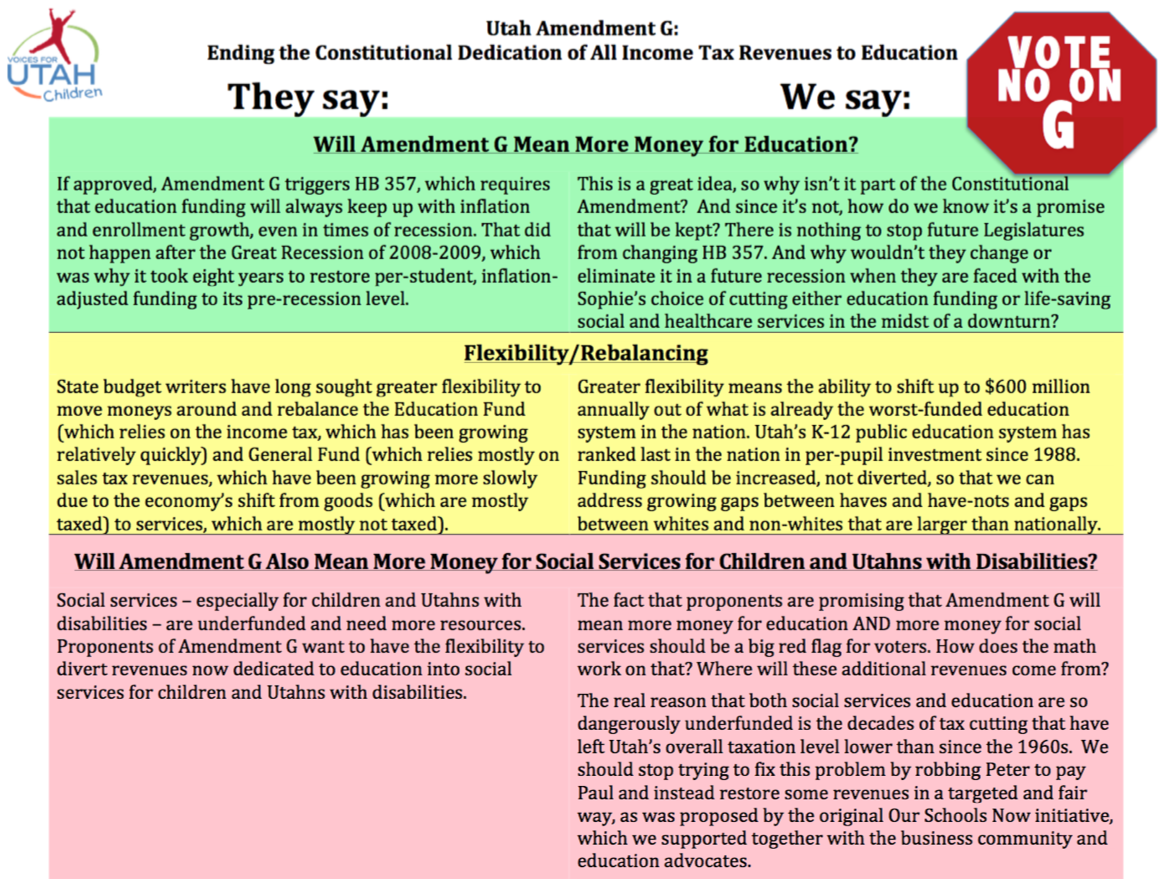
Voices for Utah Children has also published a full five-page position paper that is available in pdf format.
This press conference was broadcast live at
Media coverage:

